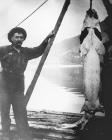1
Winter was an idle time for boats, ice being such a problem. The Bonnington, mothballed late in the year, would not resume activity until the spring. Most of the runs were taken by the Minto pushing a barge. The situation would worsen in January of 1917. Through a heavy, wet snow storm, the Rossland, parked beside the Bonnington, listed to the rear, took on more water and turned on her side. Loosened, the motors went crashing through the hull and rendered the boat a complete wreck. Now the CPR was down to the Minto, a broken Kootenay and a summer boat to look after the Arrow Lakes. By 1919 the Kootenay too was scrapped, sold to Capt. Sanderson where he turned it into a home and workshop parked at Pingston.The war was over in 1918 leaving more than 60,000 Canadians dead and a mass of men returning to civilian life, seeking new jobs. On the lakes, things were good and bad. Mills: at Comaplix (burned), Arrowhead (Big Bend burned), (Arrow Lakes Lumber Co. Shut down), Pingston (running), Nakusp (Quance, running), Summit Lake (Allshouse, running), Wesley (Bowman burned), Renata (running), Castlegar (Waldie running). People were optimistic but the twenties would arrive before major change took place.




